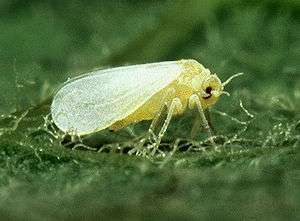| Silverleaf Whitefly | |
|---|---|
 | |
| Type: | Insect |
| Binomial: | Bemesia argentifolii |
| Family: | Aleyrodidae |
| Order: | Hemiptera |
| Metamorphosis: | Simple |
The silverleaf whitefly (Bemisia argentifolii, formerly referred to as sweetpotato whitefly-strain B Bemisia tabaci) is one of several whiteflies that are currently important agricultural pests. The silverleaf whitefly was first found in poinsettia crops in Florida in the mid-1980's. It was found to have moved on to tomatoes and other fruit and vegetable crops less than a year later. Within five years, the silverleaf whitefly had caused over $100 million in damage to the Texas and California agriculture industries.
Description
The adult silverleaf whitefly is about 1 millimeter in length and pale yellow in color.
Symptoms and Signs
In addition to inflicting typical whitefly-type damage on plants, this species can transmit plant viruses such as geminiviruses. The broad mite (Polyphagotarsonemus latus) also uses the whitefly as a dispersal mechanism by clinging to the legs of the fly and dropping off at another plant.[1]
Ecology
Host plants
- Abelmoschus (Okra)
- Acacia
- Amaranthus
- Arachis (Peanut)
- Arum
- Aster
- Asystasia
- Begonia
- Brassica
- Callistemon (Bottle Brush)
- Canna
- Capsicum
- Carica (Papaya)
- Centaurea (Bachelor’s Buttons)
- Chenopodium
- Citrullus
- Coccinia (Scarlet Gourds)
- Coleus
- Colocasia (Taro)
- Convolvulus
- Cucumis
- Cucurbita
- Dahlia
- Dendranthema
- Euphorbia
- Ficus
- Gerbera
- Glycine (Soybean)
- Fuchsia
- Gossypium
- Hibiscus
- Hydrangea
- Impatiens
- Ipomoea
- Iris
- Lactuca (Lettuce)
- Lagerstroemia (Crepe Myrtle)
- Lantana
- Lycopersicon
- Malva
- Mandevilla
- Medicago
- Persea (Avocado)
- Petunia
- Phaseolus
- Physalis (Ground Cherry)
- Plumeria
- Primula
- Rosa
- Solanum
- Verbena
- Viola
Control
This particular pest has been shown to be a good candidate for biological pest control, as it has several natural enemies, including parasitic wasps such as Encarsia and Eretmocerus.
References
- ↑ Fan, Yuqing; Petitt, Frederick L. (Jul 1998). "Dispersal of the broad mite, Polyphagotarsonemus latus (Acari: Tarsonemidae) on Bemisia argentifolii (Homoptera: Aleyrodidae)". Experimental & Applied Acarology 22 (7): 411–5. doi:10.1023/A:1006045911286. http://www.springerlink.com/content/p62501x2382ph231/. Retrieved 2007-02-21.